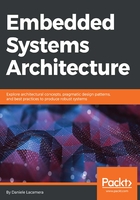
What this book covers
Chapter 1, Embedded Systems – A Pragmatic Approach, is an introduction to microcontroller-based embedded systems.
Chapter 2, Work Environment and Workflow Optimization, describes the tools used and the development workflow.
Chapter 3, Architectural Patterns, is about strategies and development methodologies for collaborative development and testing.
Chapter 4, The Boot-Up Procedure, analyzes the boot phase of an embedded system, boot stages, and bootloaders.
Chapter 5, Memory Management, suggests optimal strategies for memory management.
Chapter 6, General-Purpose Peripherals, describes access to GPIO pins and other generic integrated peripherals.
Chapter 7, Local Bus Interfaces, guides the reader through the integration of serial bus controllers (UART, SPI, I2C).
Chapter 8, Low-Power Optimizations, explores the available techniques of reducing power consumption on energy-efficient systems.
Chapter 9, Distributed Systems and IoT Architecture, introduces the available protocols and interfaces required to build distributed and connected systems.
Chapter 10, Parallel Tasks and Scheduling, explains the infrastructure of a multi-tasking operating system through the implementation of a real-time task scheduler.
Chapter 11, Embedded Operating Systems, is an overview of the available open source operating systems for the embedded world, focusing on the safety and security mechanisms implemented.